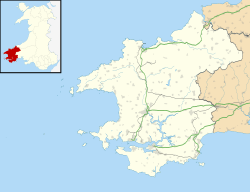Waun Mawn facts for kids

Standing stone and prostrate stone
near Cnwc yr Hŷdd, Waun Mawn in October 2012 |
|
| Location | Near Tafarn y Bwlch, Brynberian, Pembrokeshire, Wales |
|---|---|
| Coordinates | 51°58′18″N 4°47′28″W / 51.9716°N 4.7912°W |
| Type | Stone circle site |
| History | |
| Periods | Neolithic |
| Site notes | |
| Archaeologists | Mike Parker Pearson |
Waun Mawn (pronounced "wine mown") is an ancient place in the Preseli Hills of Pembrokeshire, Wales. Its name means "peat moorland" in Welsh. This site dates back to the Neolithic period, also known as the New Stone Age.
Experts have described Waun Mawn as either a line of stones or a large stone circle. If it was a stone circle, it would have been about 110 meters (360 feet) wide. This would make it the third largest stone circle ever found in Britain.
Today, only four stones remain at Waun Mawn. One stone stands upright, and three others lie on the ground. Close by, you can find the "Troed y Rhiw" standing stones. To the west, there is another single standing stone called the 'Waun Mawn Stone'. This stone is about 2.3 meters (7 feet 7 inches) tall.
The site is located about 1.6 kilometers (1 mile) southwest of a village called Brynberian.
Contents
Exciting Discoveries at Waun Mawn
Between 2017 and 2018, a team of archaeologists from UCL led by Mike Parker Pearson explored Waun Mawn. They suggested that the site once held a stone circle. This circle was thought to be 110 meters wide, just like the ditch at Stonehenge.
The archaeologists also found a unique pentagonal (five-sided) stone hole at Waun Mawn. This hole looked very similar to a pentagonal stone (stone 62) found at Stonehenge. Both stone circles also seemed to line up with the midsummer solstice, which is the longest day of the year.
Was Waun Mawn Connected to Stonehenge?
Professor Parker Pearson used a method called luminescence dating to study the soil inside the stone holes. He believed the Waun Mawn stone circle was built around 3400–3200 BC. Then, before 2120 BC, he suggested the stones were taken apart. They might have been moved all the way to Stonehenge in Wiltshire, which is about 225 kilometers (140 miles) away.
Parker Pearson's ideas were published in a science magazine called Antiquity. This idea of moving stones reminded some researchers of an old story. In the 12th century, Geoffrey of Monmouth wrote a book called History of the Kings of Britain. In it, he told a tale about the wizard Merlin moving the stones of the Giant's Dance circle from Ireland to Stonehenge.
The story of Waun Mawn and its possible link to Stonehenge was featured on a BBC Two TV show. The program, called Stonehenge: The Lost Circle Revealed, aired on February 12, 2021. Professor Parker Pearson and Professor Alice Roberts were part of the show.
Different Ideas About Waun Mawn
Not everyone agrees with the idea that Waun Mawn was a stone circle that moved to Stonehenge. Timothy Darvill, a Professor of Archaeology, wrote an article about it. He said that the idea of stone circles at both sites, with one supplying stones to the other, "does not stand up to close scrutiny." This means he found reasons to doubt the theory.
Professor Darvill believes Waun Mawn was more likely a place with "one or more stone rows, stone pairs, and standing stones." He thinks it was similar to other smaller ancient sites in west Wales.
Later work in 2021 by Professor Pearson and his team suggested that only about 30% of the proposed stone circle at Waun Mawn was ever finished. They thought 12 stones were put up, and 8 were removed a long time ago. This is much fewer than the 80 bluestones that some believe stood at Stonehenge.
Latest Findings on the Stonehenge Link
Further studies by Professor Pearson and his team have not found a direct link between Waun Mawn and Stonehenge. Two scientific papers were published in 2022. The first paper said that one stone at Stonehenge (Stone 62) came from a small rock outcrop in the Preseli Hills called Garn Ddu Fach. It also suggested that the origins of other stones at Waun Mawn still needed to be found.
In the second paper, researchers confirmed that all the stones still at Waun Mawn came from a place called Cerrig Lladron. Since no stones from Cerrig Lladron have been found at Stonehenge, it seems unlikely that stones were moved from Waun Mawn to Stonehenge.


